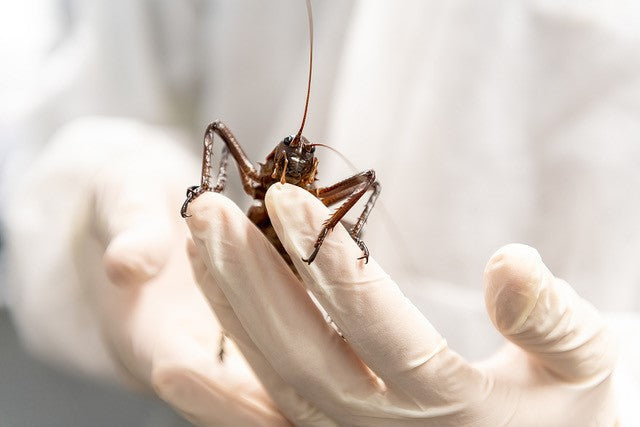
Otorohanga Kiwi House : Captive breeding The Mahoenui Giant Weta
The Otorohanga Kiwi House is a true Kiwi Weta success story!
New Zealand has been isolated from the rest of the world for more than eighty million years. It has no native land mammals aside from bats, seals, and sea lions. In the absence of land mammals, other species have evolved in wild and wonderful ways.
One of those species is the native weta, a flightless cricket. They are among the heaviest insect species in the world, and about a hundred different species exist in New Zealand. Amazingly, much like many of the birds in New Zealand, they have lost the power of flight.
Since the introduction of predators in the 19th century, weta populations have seen a significant decline across New Zealand. Possums, rats, mice, hedgehogs, cats, and stoats have led to many species of weta being considered at risk of extinction.
Otorohanga Kiwi House is located south of Hamilton on the North Island of New Zealand and has been operating as a wildlife sanctuary for more than fifty years. They have a breeding program for the Mahoenui Giant Weta, one of eleven giant weta species in New Zealand. The Mahoenui Giant Weta is a locally native species of weta discovered in 1962, initially found on just a five-hectare piece of Tawa forest on the edge of King Country in Waikato. In 1987, a second population was found on farmland nearby, which was covered in introduced gorse.
The Department of Conservation purchased the farmland and turned it into a weta sanctuary. Amazingly, the wild gorse on the farmland seems to keep out rats and possums, while introduced goats browsing seems to help the regrowth of the gorse. So, it’s a unique scenario where two introduced pest species (gorse and goats) keep a third species (weta) safe from two other introduced species (possums and rats).
However, despite the success of the nearby wildlife sanctuary, breeding programs are critical to the long-term survival of the species. This is where the Otorohanga Kiwi House has become so vital to the Mahoenui Giant Weta.
Breeding Mahoenui Giant Wētā has historically been an enormous challenge. Previous attempts at conservation breeding saw success rates as low as 0–2%, with little available research to guide efforts. Most existing information was based on the Wetapunga (Deinacrida heteracantha), another giant wētā species. Yet, the team at Otorohanga Kiwi House quickly discovered that key differences made existing methods ineffective.
Starting completely from scratch, they embarked on an intensive learning process—observing behaviour, trialing different approaches, and developing entirely new husbandry techniques. Through perseverance, they created a new set of best-practice manuals tailored specifically for Mahoenui Giant Wētā, dramatically increasing the breeding success rate to over 75%.
This breeding success is critical as it provides new wētā for predator-free wild sites, increasing the odds of survival for the species long-term, particularly should something happen to the primary locations they exist in. One of the key challenges of breeding Mahoenui Giant Wētā is that their life cycle is much shorter than other giant wētā. Oftentimes, they only live a couple of years in captivity, while other species of giant wētā typically live longer than five years, and in some instances, closer to ten.
Since the beginning of 2025, the team at the Kiwi House has successfully raised over 400 wētā and recently completed the release of 60 individuals into carefully selected, predator-controlled environments. This is critical, as three new predator-controlled environments have now been launched, including private land in Warrenheip near Cambridge, Mahurangi Island off the Coromandel coast, and Sanctuary Mountain in Waikato.
The Kiwi House team currently has over 450 Mahoenui Giant Wētā on-site and is already preparing for the next major release.
Want to learn more? Visit the Kiwi House here!
Want to view of other collaborations? Check out our recent collaboration with Predator Free NZ